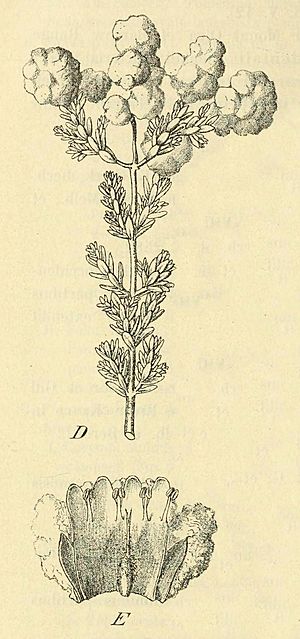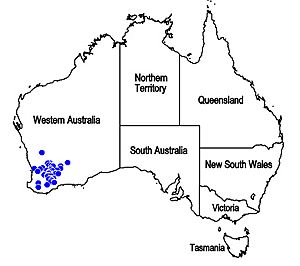Dicrastylis corymbosa facts for kids
Quick facts for kids Dicrastylis corymbosa |
|
|---|---|
 |
|
| Scientific classification | |
 |
|
| Synonyms | |
|
Dicrastylis glauca Munir |
Dicrastylis corymbosa is a special kind of plant. It belongs to a group of plants called Dicrastylis, which are part of the Lamiaceae family. This plant is only found in Western Australia. This means it's endemic there, like a unique treasure!
Contents
What is Dicrastylis corymbosa?
Imagine a small, bushy plant that grows up to 30 centimeters (about 12 inches) tall. That's Dicrastylis corymbosa! It likes to grow in sandy areas, especially where the sand is yellow and brown.
What Does It Look Like?
This plant has many branches, making it look quite full. Its stems are round, and they don't have any special scales. The leaves grow in pairs, opposite each other on the stem. They are usually 4 to 15 millimeters long and 2 to 5 millimeters wide. These leaves have tiny, branched hairs on them.
The flowers are small and pretty. They grow on short stalks, which also have tiny hairs. Each flower has five small parts called lobes, which are like tiny petals. The main part of the flower, called the corolla, is white or cream-colored. It's about 3.8 to 4.5 millimeters long. Inside the flower, there are five stamens, which are the parts that make pollen.
Where Does It Grow?
Dicrastylis corymbosa is found only in Western Australia. Specifically, it grows in two main areas there: the Eremaean Province and the South-West Province. These areas have different types of environments, but this plant is happy in both!
How Was It Named?
Scientists give every plant a special two-part name, like a first and last name. This helps everyone around the world know exactly which plant they are talking about.
Dicrastylis corymbosa was first described by a scientist named Stephan Endlicher in 1838. He first called it Mallophora corymbosa. Later, in 1978, another scientist named Ahmad Abid Munir moved it to the Dicrastylis group. That's how it got its current name, Dicrastylis corymbosa.

